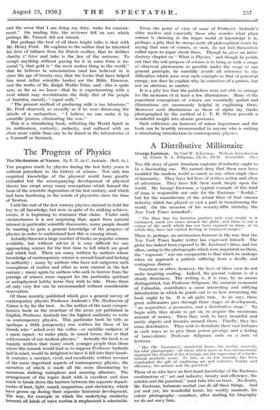A Distributive Millionaire
George Eastman. By Carl W. Ackerman. With an Introduction by Edwin R. A. Seligman, LL.D., Ph.D. (Constable. 24s.) Time life story of great American captains of industry ought to be a fascinating one. We cannot deny that these men have moulded the modern world as much as any other single class of humanity. They have led lives of restless action and often of adventure. They have left their mark deeply upon the world. Mr. George Eastman, a typical example of this kind of man, is responsible not only for the Eastman " Kodak," but for the manufacture of the actual films of that cinema industry which has played so vast a part in transforming the world. On the occasion of his seventy-fifth birthday the New York Times remarked :
" The Sims that his factories produce earl, year would, it is estimated, reach ten times around the globe, and there is not a corner of the earth which has not been exposed to them, or to which they have not carried fleeting or treasured images."
There is, perhaps, an unconscious humour in the way that the New York Times leader writer has expressed himself. The globe has indeed been exposed to Mr. Eastman's films, and too often, owing to the photographs which were imprinted on them, the " exposure " was one comparable to that which we undergo when we approach a patient suffering from a deadly and contagious disease.
Somehow or other, however, the lives of these men do not make inspiring reading. Indeed, the present volume is of a steady dreariness. The writing is, it is true, by no means distinguished, but Professor Seligman, the eminent economist of Columbia, contributes a most interesting and edifying introduction in which he points out to us how interesting the book ought to be. It is all quite true. As he says, these great millionaires pass through three stages of development, " an acquisitive, a possessive, and a distributive stage." To begin with, they desire to get on, to acquire the maximum amount of money. Then they wish to have beautiful and costly objects and luxuries around them. Finally, they be- come distributive. They wish to distribute their vast fortunes in such ways as to give them power, prestige, and a feeling of benevolence. Professor Seligman ends on a note of lyricism.
"his (Mr. Eastman's) wonderful home, his weekly musicals, his color photography—all these, which more or less unconsciously represent the deepest of his strivings, are the expression of a funda- mental aesthetic sense. To him, as to few mortals, has been vouchsafed the gift of combining art and industry, beauty and efficiency, the artistic and the practical."
Those of us who have no first-hand knowledge of the Eastman combination of " art and industry, beauty and efficiency, the artistic and the practical," must take this on trust. No doubt, Mr. Eastman, fortunate mortal, can do all these things. And yet and yet, Isis wonderful home, his weekly musicals, his colour photography—somehow, after reading his biography we do not envy him.
































 Previous page
Previous page